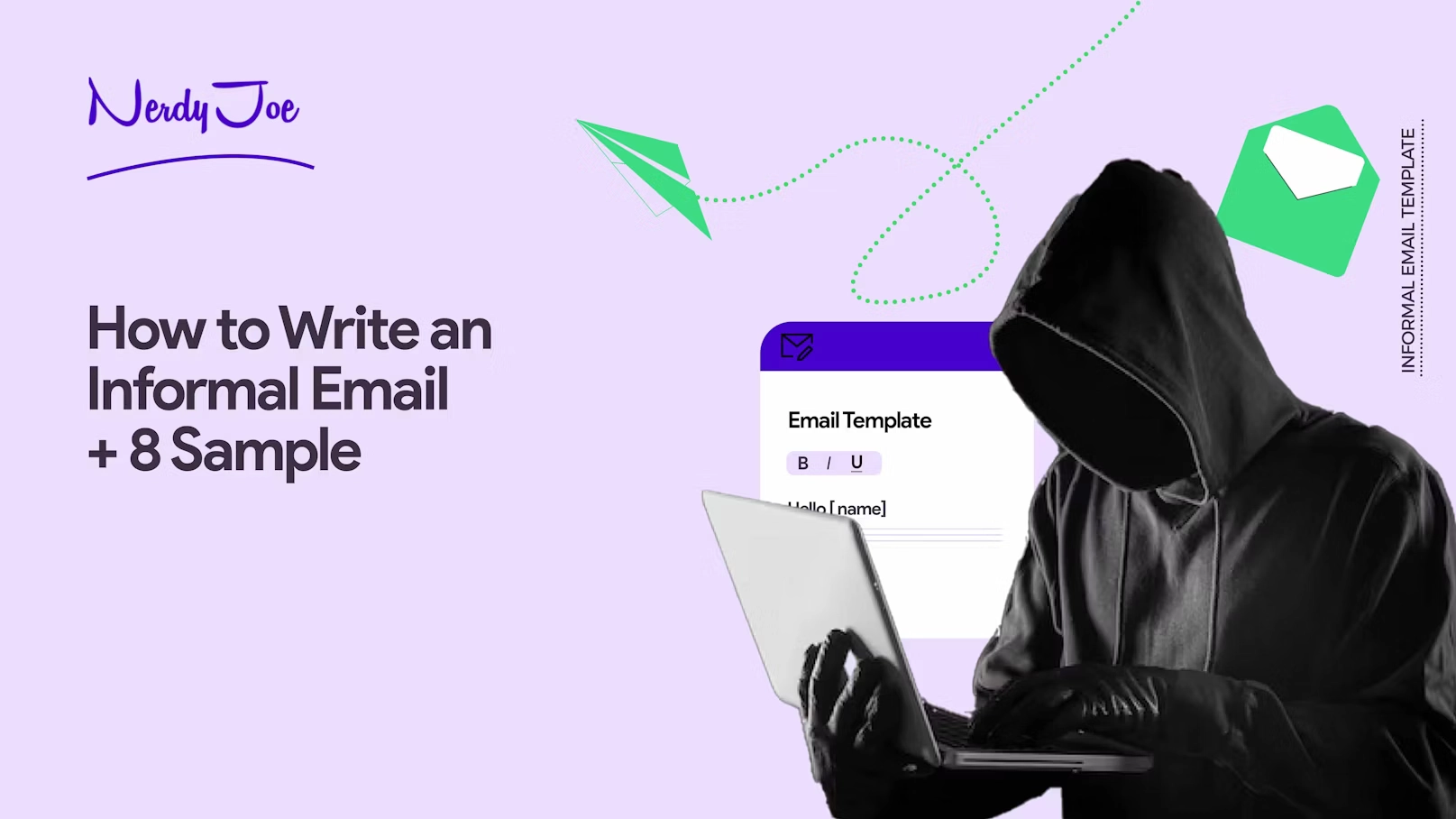Yes, you saw that right.
1200+ event registrations.
The client initially had a goal of 800 registrations. So that’s 150% more registrations than they planned.
How did that happen?
Well, it was a blend of pre-event email marketing + post-event email marketing campaigns.
Full disclaimer: Nerdy Joe was only in charge of writing the email copy plus the subject lines, social media copy, ad copy, and promotion landing pages.
In this piece, you’ll learn how we planned the campaign, the reasoning behind our email copy, and more. Most importantly, you’ll also understand why most event marketers struggle with promotion and how we did that with — almost — perfection.
Note: Have a great audience and struggling to nurture them and boost your revenue from email marketing? For $799, we’ll help you set up email sequences and automation that will generate money while you’re sleeping. Book a meeting now.
The Pre-event Email Marketing Strategy That Helped Get 1200+ Subscribers in a Few Weeks
In regard to our client’s goal, we came up with a 7-step email sequence to promote the event, handle objections, reduce friction, and boost sign-up. Here’s how that played out.

But before we move on, here are a few things to keep in mind:
- The email list we worked with has been purchased. It was not built from scratch by the client, and that made it hard to boost engagement metrics.
- The majority of people in that list, although from the same industry as our client, hate unsolicited emails and don’t hesitate to opt-out.
The client was in a rush, and we just tried to pull what we could.
Hooking Subscribers Using an Event Announcement Email
This is the first email we wrote as part of the pre-event email marketing campaign. It was straight to the point, and we made sure it was not gimmicky.
Still, when we started brainstorming the email copy, we thought we’d take a creative approach to craft the emails. Something along the lines of what Ad World or HubSpot would do.
Then, we recalled that our client is in the manufacturing space. Their email list is made up of VPs of Marketing, VPs of 3D Printing, VPs of Sales, and VPs of Procurement who have, on average, 20 — 30 years of experience and worked at companies like HP, L’Oreal, Facebook, etc.
As a rule of thumb, these types of C-level executives don’t have time to waste, and they prefer a direct style of communication.
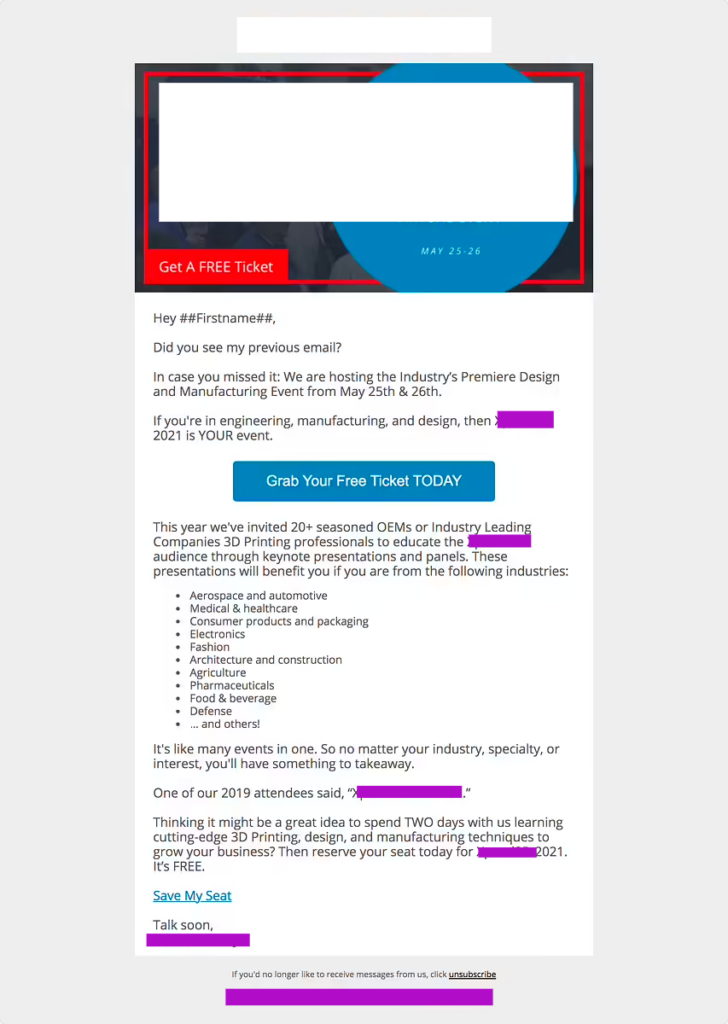
So, here’s how we approached writing the event announcement email.
- We started by figuring out something (fact, joke, or news) to hook the recipients.
We figured that post covid most manufacturers were looking for ways to reduce their manufacturing production costs.
And it happened that our client has a case study about how they helped a manufacturing company reduce production costs by 92% by going additive.
So, we used that statistic to lead. - Then we followed up with a sentence that introduces the event and positions it as the best place to learn about industry trends and best practices to streamline production and reduce costs.
- You can also notice how we called out things like CNC Machining, 3D Scanning, etc., to make them realize that it’s not just an event for manufacturers but also for people from these industries.
- We then included a CTA, right two lines into the email. That’s for anyone who wants to or already knows the event to register automatically without thinking. Yes, that tactic works if you want to sell a lot of early-bird tickets.
- Then followed up with more details about the event and bullet points of what they will learn or discover if they signed up. And ended up with another call to action.
- Notice how we reduce friction with a P.S. note that makes it clear that they should still register even though they will not attend. Because that’s a way for us to know that they want in but are busy. Then we can send them the recording.
That first email of the pre-event email series has worked relatively well, given that the list has been purchased. It scored a 1.06% click-through rate, which is almost 214 people showing interest in the event.
Following Up On The Offer Using Event Reminder Email
This is the second email we sent as part of our pre-event email series.
Since we weren’t sure about deliverability and email engagement (initially because that list was purchased), we thought it would make sense to send a reminder email for those who missed out on the first email and those who simply didn’t have the time to click through and register.
We started the email by reminding them of the event details and dropping out some industry names so that attendees, regardless of their background and industry, could feel that the event was designed for them as well.
Then, like usual, right after the first few lines, we included a CTA for anyone willing to act on the event invitation.
For those who read the previous email but needed more information before acting up, we included a line after the CTA to fix that. We mentioned the number of event speakers, keynotes, and sessions.
We also made bullet points to list out the different industries that’ll attend and benefit from the event. If you’ve noticed, up until now, we’ve been superficial about the target audience/industries. In this reminder email, we thought it’d make sense to give up as much information as possible.
Now, usually, when you name-drop tons of industries for your event, most people think, “Jack of all trades, master of none.”
To some extent, that makes sense. If you’re going to attend a 3-day event, better make sure you will learn something and not waste your time.
So, to address that objection, we came up with this sentence, “It’s like many events in one. So no matter your industry, specialty, or interest, you’ll have something to take away.” This is basically another way of saying: “Don’t worry, you will not waste your time.”
As part of the objection handling, we also thought it’d make sense to include a testimonial from one of the attendees of the previous events.
To end the email, we used a soft call to action to give the recipients a last nudge to sign up.
That call to action clearly states the ask, which is, “Think it might be a great idea to spend TWO days with us,” and the benefit of acting on that CTA, “learning cutting-edge 3D Printing, design, and manufacturing techniques to grow your business.”
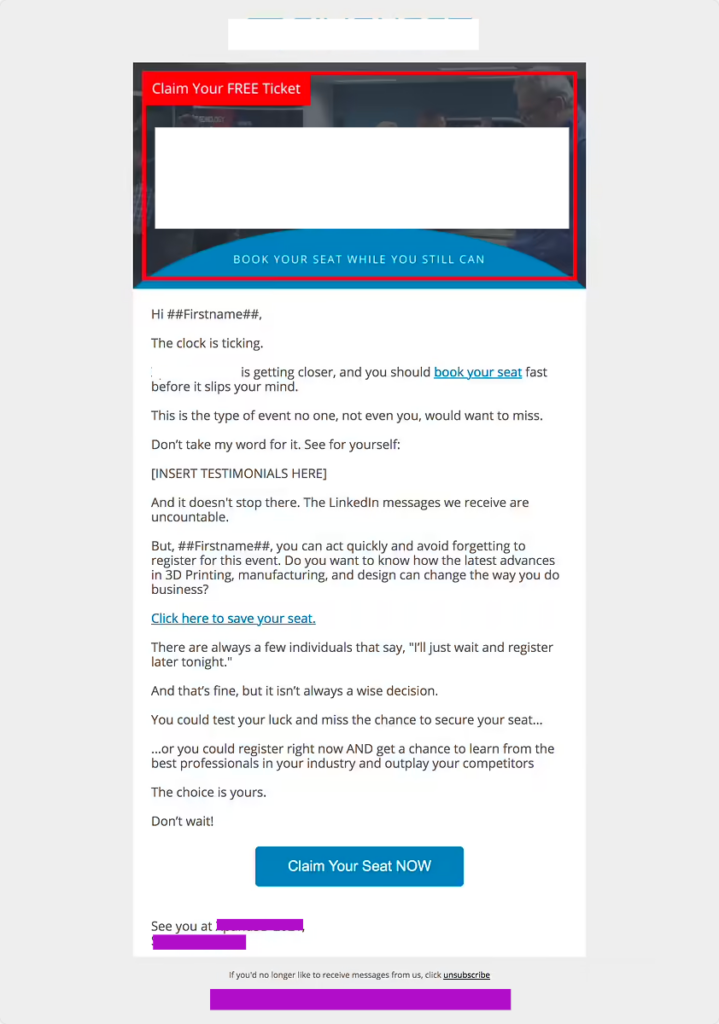
This email did slightly well and better than the previous one by scoring a 1.40% clickthrough rate (up from 1.06%), which is approximately 280 people clicking through to learn more about the event.
Addressing Objections Using A Don’t Miss Out Email
In this third email promotion series, we’re a little bit more aggressive than usual. Because we’re now dealing with people who have the necessary information about the event but haven’t signed up.
Here, we’re arguing the different reasons they shouldn’t miss out on the event — and handling objections at the same time.
You can also notice that we’ve increased the number of CTAs from 2 to 3 to reflect the urgency to act fast.
The email starts by pointing out that the clock is ticking and registrations will be closed in a few.
Then, we reinforced their willingness to attend the event by featuring a handful of testimonials from past event attendees. And follow up with a second CTA.
We ended this email by addressing some objections and increasing the urge for the recipient to sign up.
One of the common objections or frictions when it comes to registering for an online event or a webinar is that people always procrastinate.
“I’ll do it tonight!”
“I’ll sign up in a few.”
“I’ll do it when I get some free time.”
The thing is, they never find the time, and when they do, they end up missing the seat.
So, to address this objection, we clearly stated the problem, which at the time of reading the email, most of the readers were thinking about.
Then we lead with reasons why they shouldn’t do what they were thinking of. We do this in a subtle yet soft way to avoid frustrating the recipients.
Here’s how we have done this.
“There are always a few individuals that say “I’ll just wait and register later tonight.”
And that’s fine, but it isn’t always a wise decision.
You could test your luck and miss the chance to secure your seat…”
Once we’ve addressed that, we then followed up with a solid reason to act on the CTA now, not tomorrow.
Here’s how we put it.
“…or you could register right now AND get a chance to learn from the best professionals in your industry and outplay your competitors.
The choice is yours.”
As you can see, we gave them a choice, and that somehow impacted the clickthrough rate.
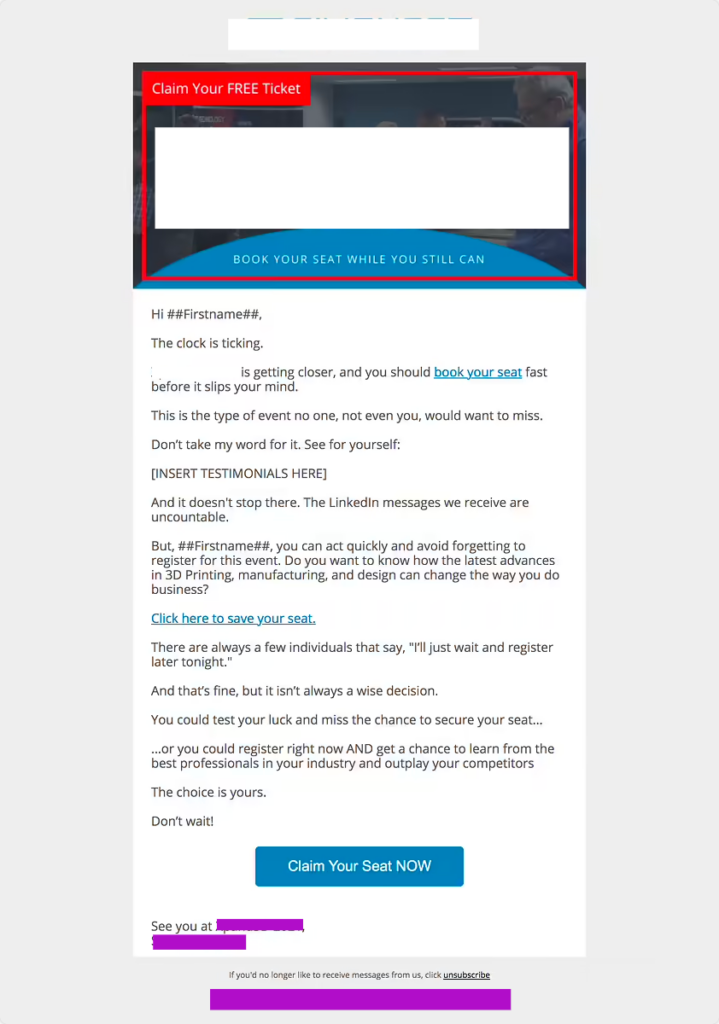
253 people showed interest and clicked on the event registration link, which took them to a landing page where they could register using a signup form.
Creating FOMO Using A Countdown Email
As the deadline was getting closer, we leveraged marketing tactics such as FOMO, urgency, scarcity, and more.
First thing first, we use a sophisticated email marketing platform to create a timer that urges email recipients to sign up fast before the offer expires.
What did we do next?
Well, we made the recipients feel somehow guilty for not signing up. Not in a bad way! But in a way that makes them feel like they’re missing out.
In the middle of the email, we also thought it’d be great to emphasize the VALUE of attending the event live.
Hence, “After that timer hits “-0-“, you’ll only be able to watch the replay and miss on THE OPPORTUNITY to ask live questions to the Keynote Speakers.
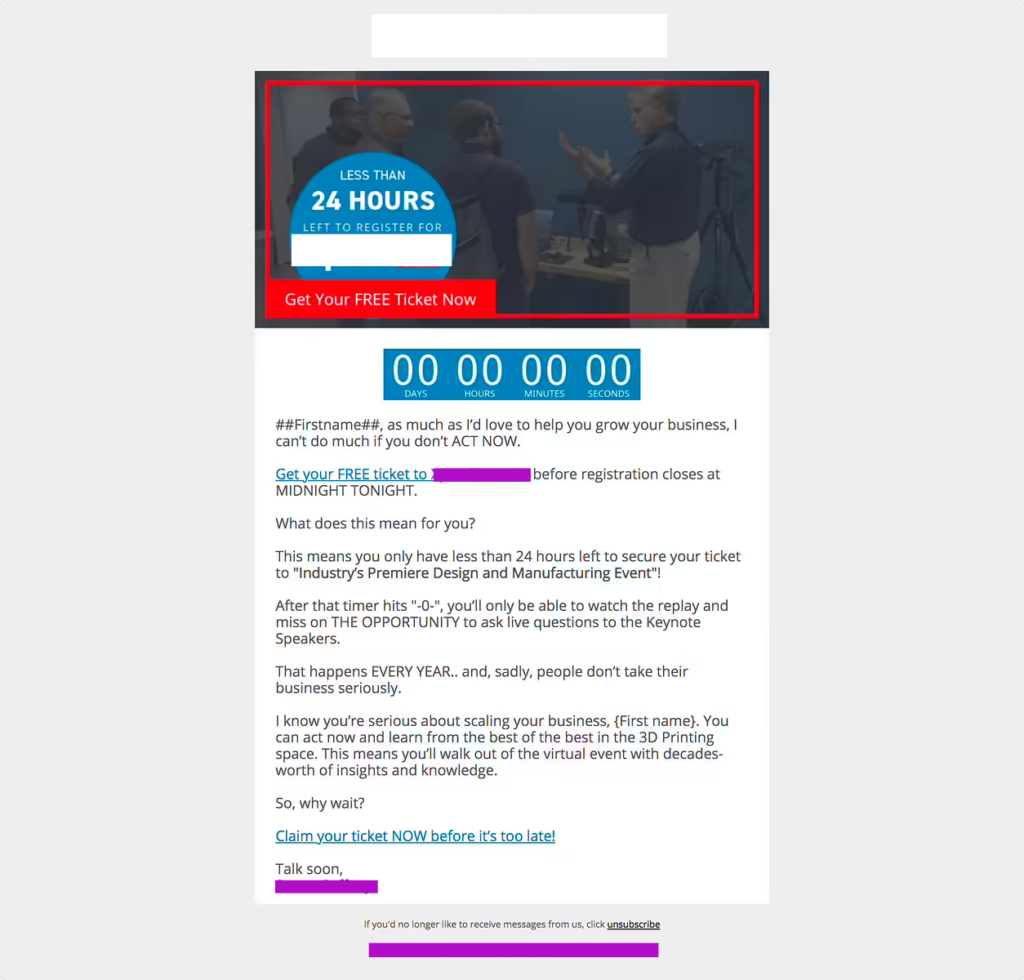
Urging Late Adopters To Sign Up Using A Last Chance Email
We set the email automation in a way that this email goes out as soon as the timer hits “0” on the previous email. It’s like a follow-up email campaign for the previous two emails.
You probably may have noticed that the email copy keeps getting shorter and shorter as we go further down the campaign. That’s because the very first batch of emails has done a good job of giving away the details, such as the event date, event venue, timing, etc.
The goal towards the end of this event email campaign is to actually lead with value versus event details. We want the prospective attendees to feel like there’s so much value to that event that it’d be a mistake to miss out.
Hence the statement, “This free event is the equivalent of a $9997 course.”
By stating that in the subject line and in the email copy, we’re triggering our readers to feel like this is a once-in-a-lifetime opportunity, they should definitely take advantage of.
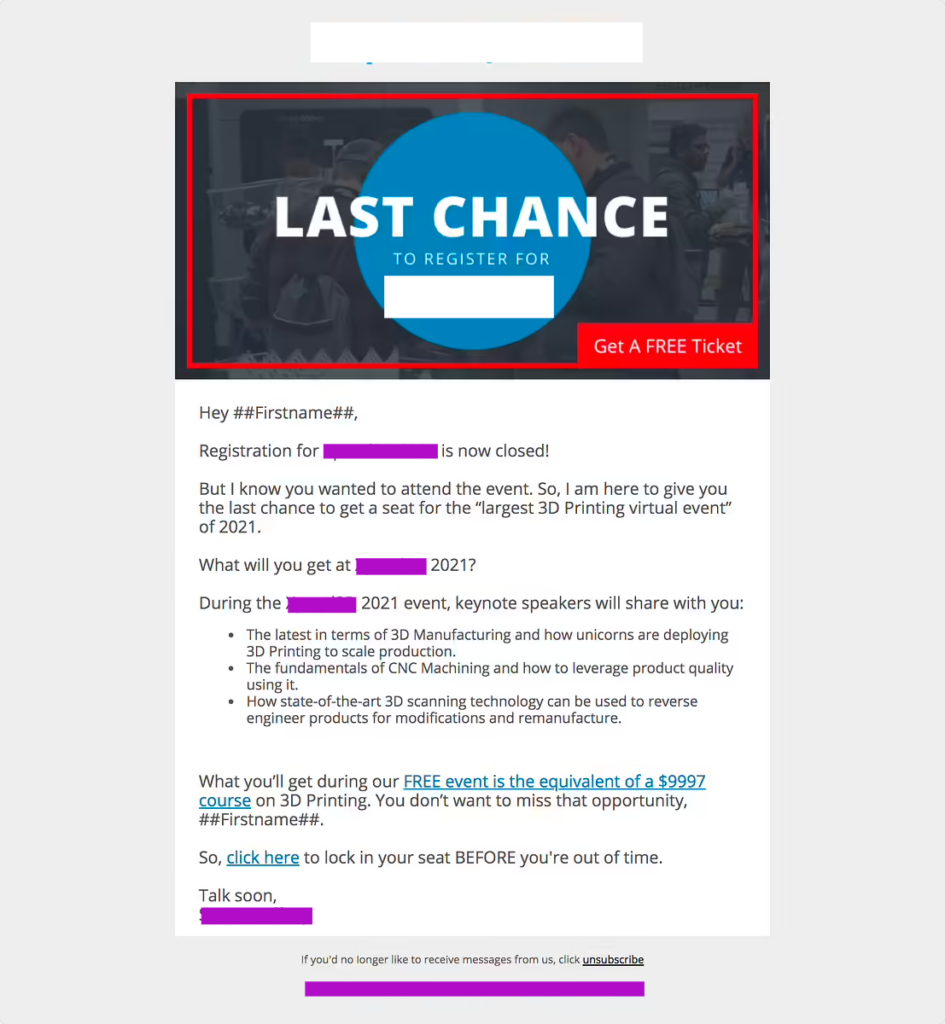
Leading with Benefits Using an Event Speaker Announcement Email & Event Agenda Email
Now that registration is closed, at least officially, we decided to share details about the keynote speakers, their topics, and the sponsor.
Usually, this type of email is more for the speakers and sponsors to get visibility. But it’s also a way to nudge late adopters to sign up for the event.
We looked at the lineup and decided to only highlight the most prominent speakers. This helps reduce friction and encourages people to register.

The Planning We Used to Ensure A Successful Campaign
For the planning, we decided to keep it simple.
- 1 email is deployed every week.
- A reminder email is triggered every time someone opens or clicks on one of the emails and doesn’t take action.
- A second reminder email is triggered when the recipients click on the first email follow-up and do not take action.
- We also have a third reminder email which is not triggered but is sent to the entire email list of people who didn’t open at all any of the emails.

As you can see, there’s no follow-up email for the post-event invitation emails. The reason for this is that the post-event emails are deployed after the event.
So, they only go to people who registered to attend the event, and the call to action in these emails isn’t as important as those in the pre-event emails.
The post-event email campaign only aims at summarizing the event and sharing the recording with those who’d like to rewatch it. Somehow, it also serves as a thank-you email.
The Post-event Email Marketing Strategy We Used Increase Attendees’ Experience
Event Follow-up Email
Most people gear their event marketing efforts toward the pre-event promotion campaign and not the post-event one. To some extent, their reasoning is right because, after all, why keep nurturing subscribers when they’ve already taken your desired action?
Wrong!
This email marketing campaign is as crucial as the pre-event one. The only difference is that here, you’re doing it to build relationships and stay top of mind for the upcoming event.
Normally, this email could have been a sequence of 3 emails, but we decided to pack it into one to avoid spamming our readers.
As you can see, we started the email by addressing a thank you to attendees and by reminding them that they made it a successful event.
We then go on to recap what happened during the event. The goal of this is to make everyone realize that they really had an impact and that we value their participation and contribution.
In the last part of the email, we ask them to share their feelings and opinion about the event. We also ask them to give us feedback on how to improve the event for years to come. Again, this consolidates the feeling that we value them and want to hear from them.
So, as you can see, we combined a thank you an email with an event recap email with a net promoter score email.
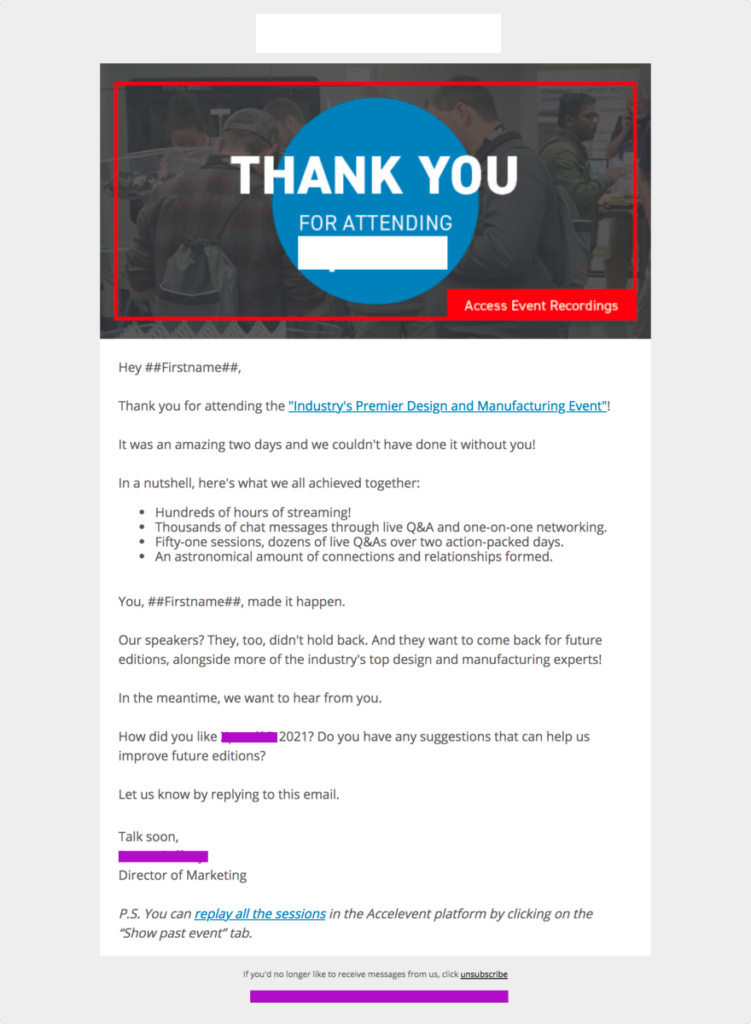
In the P.S. section, we also share the event replay link with them. We didn’t make a big deal out of that because we dedicated another email to that.
Here’s your Recording Email
This is the last event email marketing deployment of the entire entire event marketing strategy.
As a rule of thumb, we start the email with a thank you message to the event attendees.
We then go on to share the event recording link and explain the different steps to take to access the recording.
This email is also a way to increase our client’s email subscribers, as it asks attendees to invite their colleagues and friends to register to watch the recording as they’ve not been able to attend the live event.
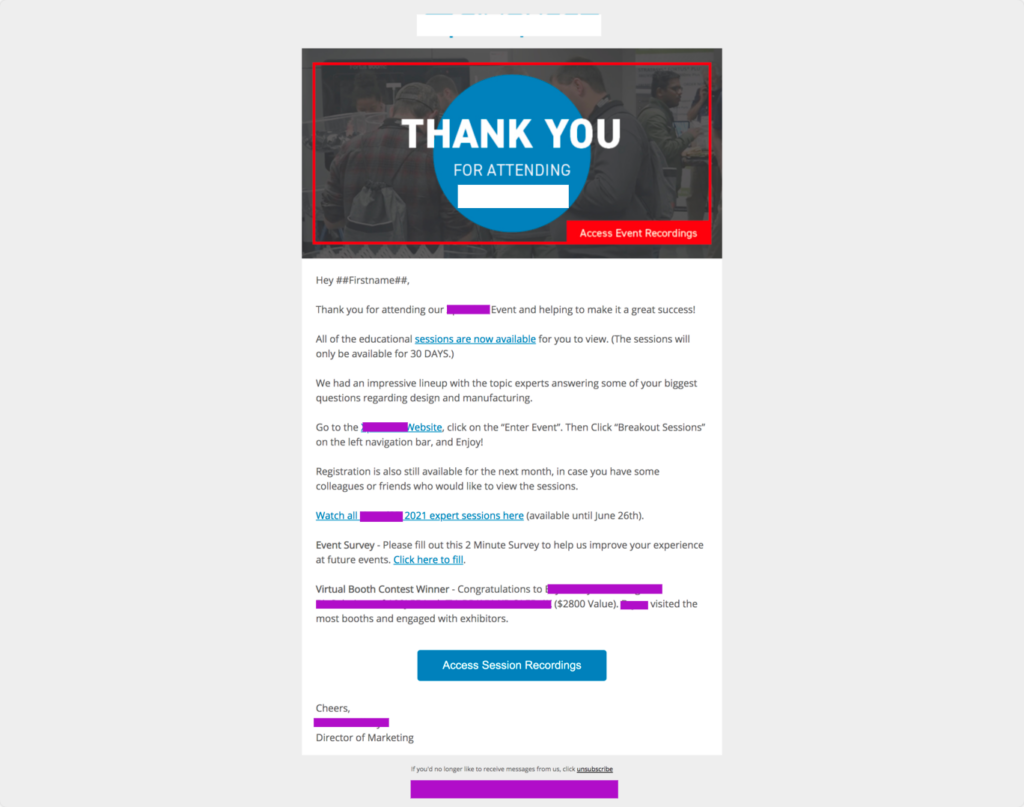
How We Ensured Great Deliverability with a Solid Email Design
If you’ve worked with us or read a few of our blog content, you already know our agency is a big plain-text email advocate. You’ve also probably realized this from how text-heavy our emails are.
But in the case of this event email marketing campaign, the client wanted to go hybrid, meaning they wanted to combine HTML-style email and plain text.
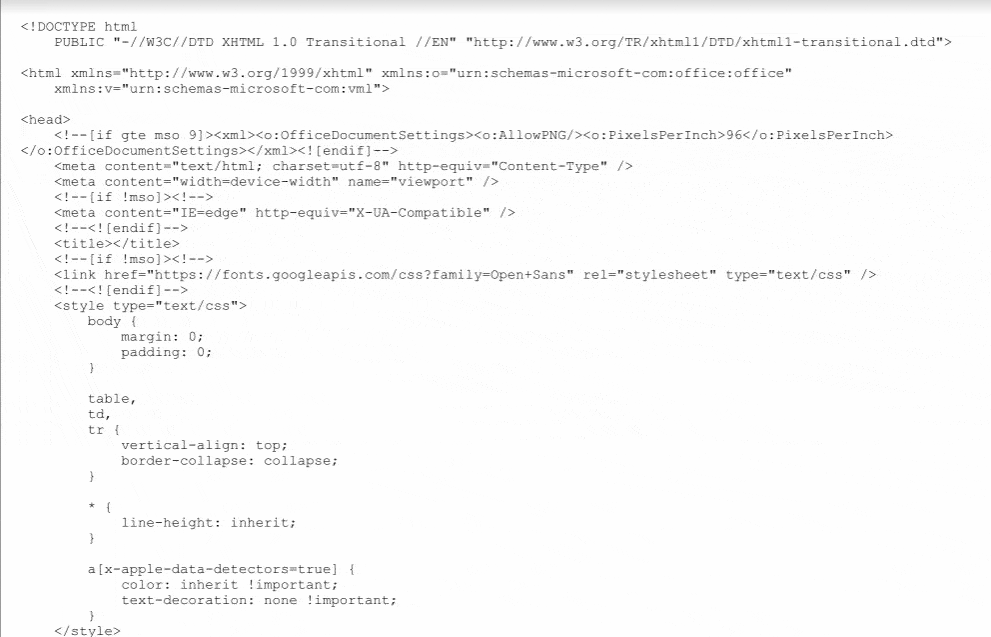
Although we weren’t involved in this part of the work, there are a few email design best practices I’d like to highlight.
- The main HTML file was not bigger than 100KB. In fact, it was 22KB. This is good for two main reasons. First, keeping your HTML files under 100KB helps keep your email out of the spam folder. Second, it also prevents Gmail from clipping the email.
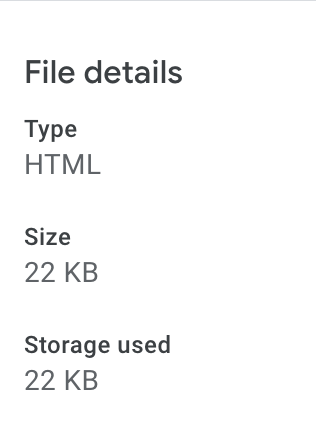
- In the code, there’s a snippet that prevents iOS or Apple devices from turning all links blue. This is good as it makes it easier to keep your brand’s design the same across the spectrum. It also improves visibility as your most important links don’t get blurred out because Apple instilled a color that doesn’t go with yours.

- Most email marketers use media queries to build custom styles for different clients or screen sizes. The “Max-device-width: 520px” option causes the styles contained in the query to trigger only on 520px screens. “Min-device-width” would do the opposite, triggering on 520px screens.

Also, in the email header, we use words and phrases that trigger action.
Here’s an example.
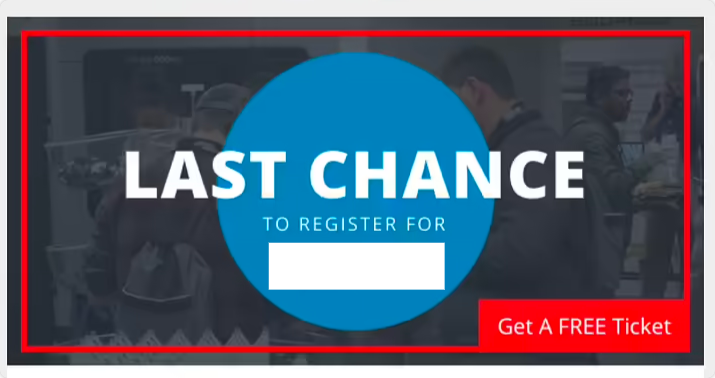
Here’s another example.
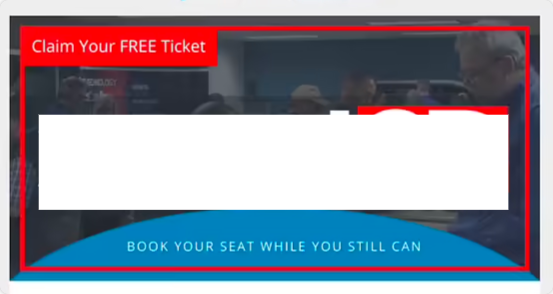
Crafting Subject Lines That Trigger FOMO, Excitement, And Eagerness
Here’s a list of the different types of subject lines that we used across this event email marketing campaign.
- Subject line 1: Free ticket to [Event Name] 2021
- Subject line 2: Quick Reminder {First Name}…
- Subject line 3: Act fast or REGRET
- Subject line 4: [Event Name] Countdown has started
- Subject line 5: [Event Name] $10K Training for Free
- Subject line 6: Reply if you attended [Event Name] 2021
- Subject line 7: Sessions are back for 30 more days
When an event promotion campaign fails to generate results, most event marketers think it’s because their sequence isn’t convincing enough or that their prospective attendees have commitment issues.
Well, the thing with event email marketing is that most people have a time management problem. And as event marketers, you have no time to waste.
That’s why from start to finish, we decided to leverage urgency and scarcity to encourage our client’s email subscribers to act fast on the event invitation.
That’s why you can see words like “Countdown,” “Fast,” “Act,” and “Reminder” across the subject lines. Those are basically power words that trigger a QUICK reaction from the readers.
But we didn’t stop there.
We also used words like “Free,” “Regret,” “30 days,” and “$10K Training” to increase the perceived value of the event while reducing friction.
I mean, who resists something that’s both valuable and free? And who’d want to miss out on $10K worth of training for free?
Let’s Help You Send Email Campaigns That Generate Cash
Are you interested in generating revenue from your existing email list but don’t know what’s the best approach to a successful email marketing campaign?
Look no further. At Nerdy Joe, we can help you with:
- A full-service email marketing offer where we take care of your entire email strategy, segmentation, list building, nurturing, and lead generation.
- A one-off email marketing campaign where we just help you hit a certain goal within a certain time frame.
Note: Have a great audience and struggling to nurture them and boost your revenue from email marketing? For $799, we’ll help you set up email sequences and automation that will generate money while you’re sleeping. Book a meeting now.
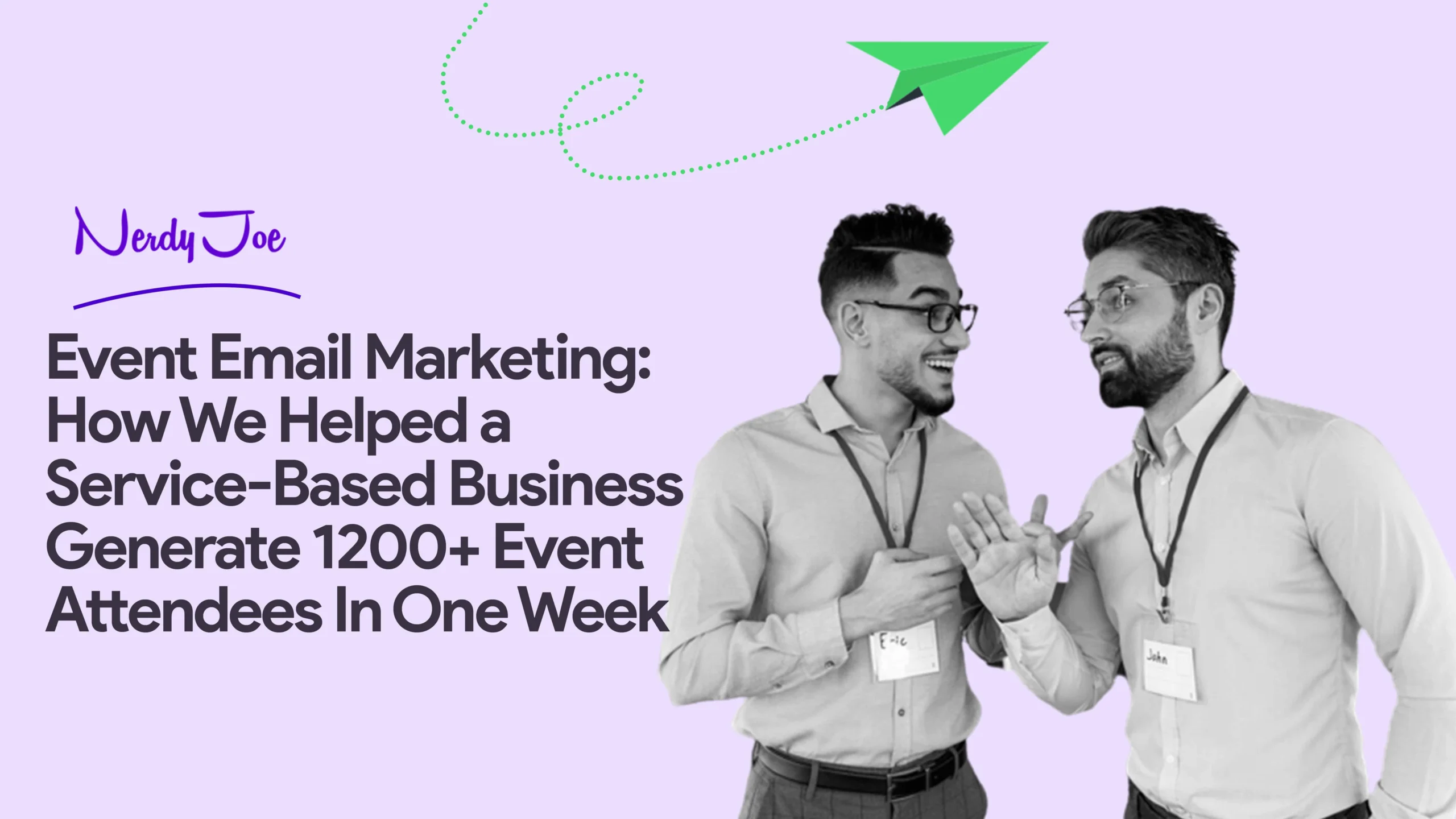
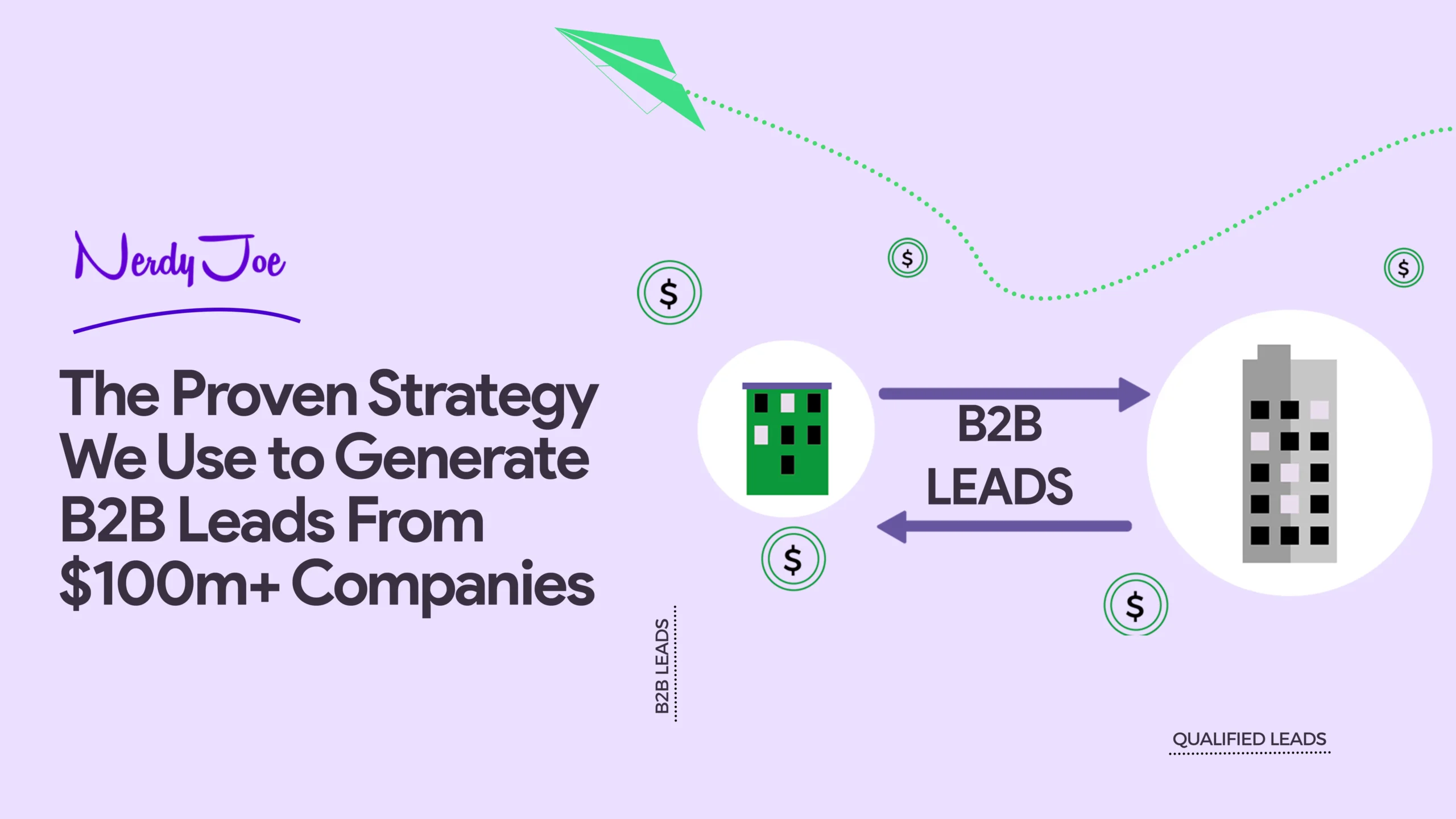
![How to Generate B2B Leads With Cold Outreach [Case Study]](https://nerdyjoe.com/wp-content/uploads/2024/06/1669218674-artboard-1-copie-4-3x-1-scaled.webp)
